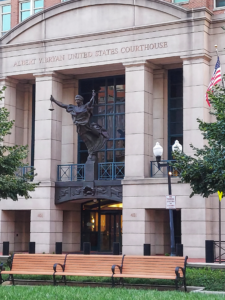The federal antitrust trial against Google that began earlier this week in Virginia went so deep into the ad tech weeds on Day Three that even this ad tech reporter was barely familiar with some of the terminology.
Truthful DRS, anyone?
Read on for an explanation as testified to by DOJ witness Professor R. Ravi, a computer scientist and academic expert in a branch of applied mathematics that involves the study of optimal resource allocation.
Because, you know, that’s just the kinda trial this is.
If you haven’t been following along, you can get up to speed quick on what’s happened so far:
- Your Day One Recap: DOJ vs. Google Goes Deep Into The Ad Tech Weeds
- The DOJ vs. Google, Day Two: Tales From The Underbelly Of Ad Tech
And here’s your Day Three rundown.
The kid on the stand
Before Prof. Ravi was called, the day started with a far less willing government witness: former Google ad executive Brad Bender.
If there’s anyone who should be a font of institutional knowledge about Google’s display advertising business, it’s Bender. He was at DoubleClick for more than a decade, joined Google as part of the acquisition in 2008 and then spent nearly 15 years rising up the ranks, including as VP of product for display and video ads.
But Bender was only testifying because he was unable to quash his subpoena. The DOJ lawyer questioning Bender asked the judge for permission to treat him as a hostile witness.
The DOJ spent a good amount of time probing Bender about several email exchanges. The first was a 2009 email Bender sent to his team that included detailed notes taken by a colleague about a talk outlining Google’s display strategy that was given by DoubleClick CEO David Rosenblatt shortly after the acquisition.
“It’s a long read,” Bender wrote in the email, “but when you have a chance, it is worthwhile to get his [David’s] perspective.”
The presentation was chock-full of unvarnished statements:
![]() For example, Rosenblatt said that without inventory access, “nothing else matters. It turns out that the most efficient way to access that inventory is by owning the primary ad server that premium and non-premium publishers use to manage their inventory. It allows you as a network the so-called ‘first look’ at each expression.”
For example, Rosenblatt said that without inventory access, “nothing else matters. It turns out that the most efficient way to access that inventory is by owning the primary ad server that premium and non-premium publishers use to manage their inventory. It allows you as a network the so-called ‘first look’ at each expression.”
![]() Also: “The origin of Google’s interest [in DoubleClick] was Google was way ahead intellectually, but was having trouble building its own primary ad server.”
Also: “The origin of Google’s interest [in DoubleClick] was Google was way ahead intellectually, but was having trouble building its own primary ad server.”
![]() And in reference to why having an exchange business is way more “sustainable” when you also own an ad server: “My view is, nothing really matters but the platform. Nothing has such high switching costs. If there’s a better network or exchange, you can just switch to it. Switching platforms is a nightmare.
And in reference to why having an exchange business is way more “sustainable” when you also own an ad server: “My view is, nothing really matters but the platform. Nothing has such high switching costs. If there’s a better network or exchange, you can just switch to it. Switching platforms is a nightmare.
“Takes an act of God to do it.”
During his direct examination, Bender noted that just because he forwarded an email doesn’t mean he agreed with every point in it.
‘The problem is that HB exists :)’
But the other email the DOJ concentrated on was even more candid – and therefore more difficult to explain away.
In March 2018, Bender received a message from Jonathan Bellack, who was in charge of product management for Google’s publisher ad platforms, observing that “a huge chunk” of publisher header-bidding revenue was actually Google demand going outside of Google’s ecosystem and then coming back in via third-party exchanges.
Bender forwarded Bellack’s message to one of his direct reports, Payam Shodjai, and wrote: “This seems pretty broken. Is there anything we can do to help with this situation in the short-term?”
 To which Shodjai responded that “it’s more complicated than ‘DBM should stop buying HB inventory.’ The problem isn’t so much that DBM is buying HB inventory – the problem is that HB exists :)”
To which Shodjai responded that “it’s more complicated than ‘DBM should stop buying HB inventory.’ The problem isn’t so much that DBM is buying HB inventory – the problem is that HB exists :)”
That’s a smiley face.
(Also, DBM refers to DoubleClick Bid Manager, which today means DV360)
Shodjai went on to casually observe that header bidding is a “no-brainer” for publishers to adopt because it gives better yield. Header bidding was only created, he noted, because “publishers felt locked in by dynamic allocation in DFP, which only gave AdX [the] ability to compete.”
It gets better (or worse?): “Since DBM is the largest buyer on many exchanges, we are also the largest buyer of HB inventory, because there’s no way for us to differentiate HB vs. non-HB inventory. So for DBM to stop buying HB inventory would mean for DBM to stop buying on 3P exchanges. This is something we can certainly discuss. It has major competitive implications.”
Then, finally, Shodjai notes that Google’s exchange bidding “stems the bleeding,” but isn’t ideal because the margins are low at 5%. Project Poirot, though, has “actually been quite effective, resulting in DBM spending 7% more on AdX and reducing spend on other exchanges.”
And scene.
Poirot vs. the exchanges
Speaking of Poirot, here’s a fun fact: Google would include little mustache graphics on some of its internal documents about Project Poirot, ostensibly a reference to Detective Hercule Poirot’s famous mustache.
We know about the little mustaches because there was an internal Google document entered into evidence analyzing the impact of Poirot’s launch, including on third-party exchanges. A chart to that effect shows a 10% drop in Rubicon’s win rate and double-digit decreases for both PubMatic and OpenX.
Google launched Project Poirot in 2016 as a bid-shading program for when DV360 would bid into exchanges other than AdX. This had the side benefit, from Google’s perspective, of tamping down on header bidding.
According to Prof. Ravi, who analyzed Poirot and other Google auction dynamics in an expert report for the government, features like Project Poirot, first look (which became last look after header bidding) and unified pricing rules (UPR) were “not well designed to optimally allocate impressions and seem to have been designed to advantage Google’s own products over others.”
In response, Google’s lawyers glommed onto the fact that, of all these algorithms, only UPR is still extant. They also said that last look, when it was still around, would result in higher CPMs for publishers because it gave AdX a chance to beat the highest header bidding bid.
On cross examination, Prof. Ravi conceded that last look would make more money for publishers if AdX bid higher than the header bidding auction. But on redirect, he had the opportunity to clarify.
Last look would have “zero benefit” to the publisher, he said, if AdX paid the same price as the winning bid, which was likely to happen if Google was able to know what price it had to meet or beat.
Tough bets
Meanwhile, according to the government, the same was true of other Google auction features, including sell-side dynamic revenue sharing (DRS).
Rather than taking a fixed margin before bidding, DRS allowed Google to adjust its take rate up or down on each impression to make AdX more competitive in auctions. That meant Google could bid higher in certain auctions by lowering its fee and then make it back later by taking a higher margin in another auction.
By winning more often, Google put itself in a position to keep on winning, in part because it was skewing overall auction dynamics in its favor and because other exchanges couldn’t lower their fees to compete for business based on price.
The DOJ entered into evidence an August 2017 email written by Martin Pál, a Google engineer and research scientist, who wrote that DRS allowed AdX to “pay high and win whenever AppNexus is present with a high CPM and pay low when AppNexus bids low.”
At some point, Google also introduced another flavor of dynamic revenue sharing called “truthful DRS.” That involved Google using machine learning to decide whether it should take 0% margin or its usual 20%.
If the algorithm surmised that Google could take a 20% fee and still win, that’s what it would do.
The last witness of the day was Jed Dederick, CRO of The Trade Desk, the only other listed witness on the buy side other than Criteo Chief Product Officer Todd Parsons, who hasn’t testified yet.
It’s not 100% clear why the DOJ wanted a DSP on the stand. Google’s DV360 DSP is The Trade Desk’s main competitor, but it isn’t part of the DOJ’s complaint, which targets Google’s publisher-focused tools.
But The Trade Desk bids into multiple exchanges, including AdX, which is one of its most important supply sources. Even so, TTD has concerns about transparency and auction integrity on AdX, he said, which the company has brought up to Google multiple times.
Made-for-advertising sites, for example, “are a huge problem in open web display,” Dederick said, and Google and AdX “are some of the largest purveyors of MFA.”
But nothing changed after these conversations, he said, including TTD’s relationship with AdX. “We would not be competitive without access to AdX,” Dederick said.
In the midst of his cross-examination and right before the trial was scheduled to wrap for the day, the defense tried to enter a TTD email into evidence that’s still under seal. There was an objection, and all members of the public and press were asked to clear the courtroom while Judge Leonie Brinkema considered what to do.
A decision will be made by the lawyers (Dederick has his own, too) about how to work out the redactions during a hearing early Thursday morning before court is back in session at 9 am ET.
The first witness of the day on Thursday is Rahul Srinivasan, who was a product manager for Google Ad Manager between 2016 and 2019. It’s possible Dederick will finish being questioned later in the day. Stay tuned.
















